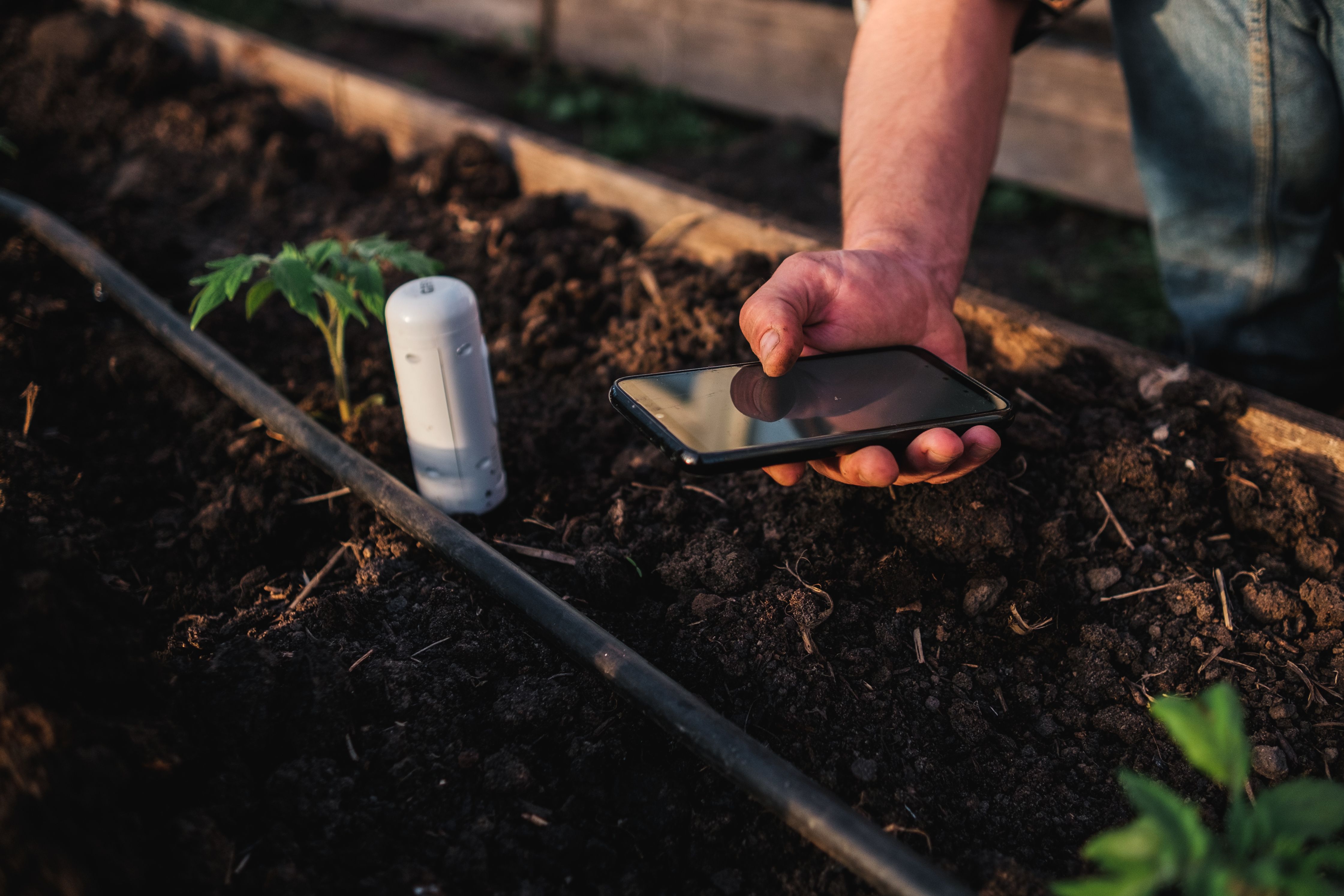New Time Series Prediction Model Tested on Measuring Soil Moisture
Scientists from Zhejiang A&F University and Huzhou University in China recently created a new time series prediction model that combines linear and nonlinear prediction methods. Their findings were published in Agriculture (1).
Gardener using mobile app checking monitoring soil moisture with smartphone | Image Credit: © memento_jpeg - stock.adobe.com

Monitoring soil moisture has become an important part of agricultural planting. Establishing an effective soil moisture prediction model can lead to better utilization of water resources, which can be significant for crop supply and overall agricultural development. Soil moisture changes can be predicted using various modeling methods, though data usually has nonlinear characteristics, which conflicts with the typical linear nature of the typical modeling methods. While the methods can address nonlinear properties of soil moisture time series, the number of parameters and empirical constants needed can be excessive. These issues compile into a need for nonlinear models; however, currently, a single nonlinear model does not obtain ideal results for soil moisture time series data when trying to measure both linear and nonlinear characteristics.
To combat this, the scientists created a hybrid time series prediction model, known as BAG (Block Hankel tensor ARIMA (BHT-ARIMA) and GRU), which combines linear and nonlinear characteristics of soil moisture. The process is based on two pre-existing models: the traditional autoregressive integrated moving average (ARIMA) method, specifically block Hankel tensor ARIMA (BHT-ARIMA), and the gated recurrent unit neural network (GRU) method. BHT-ARIMA and GRU were used to extract the linear and nonlinear features of soil moisture data, respectively. BHT-ARIMA is used to predict the linear part of soil moisture, with GRU predicting the residual series, with the final prediction result being the superposition of the two predicted results. Using this system, the proposed model was performed on five real datasets.
Compared to single linear or nonlinear models, BAG seemed to have higher accuracy for soil moisture prediction, partly due to its ability to capture the intrinsic correlation between associated environmental factors. The experiment results showed that BAG could be influenced by environmental factors and input sequence length, with correlated environmental factors also playing a key role in more accurately predicting soil moisture. Ablation experiments show that BAG can properly incorporate nonlinear characteristics of soil moisture predictions, though the influence on seasonal and climatic factors on said data are factors that require further study. Furthermore, the scientists also hope to use BAG in predicting other nonlinear time series data, such as soil temperature, rainfall, and atmospheric temperature.
Reference
(1) Wang, G.; Zhuang, L.; Mo, L.; Yi, X.; Wu, P.; Wu, X. BAG: A Linear-Nonlinear Hybrid Time Series Prediction Model for Soil Moisture. Agriculture 2023, 13 (2), 379. DOI: https://doi.org/10.3390/agriculture13020379
Newsletter
Get essential updates on the latest spectroscopy technologies, regulatory standards, and best practices—subscribe today to Spectroscopy.
AI-Powered Fusion Model Improves Detection of Microplastics in the Atmosphere
July 17th 2025Researchers from Nanjing University of Information Science & Technology have introduced a breakthrough AI-enhanced multimodal strategy for real-time detection of polyamide microplastics contaminated with heavy metals.
Radar and Soil Spectroscopy Boost Soil Carbon Predictions in Brazil’s Semi-Arid Regions
July 7th 2025A new study published in Geoderma demonstrates that combining soil spectroscopy with radar-derived vegetation indices and environmental data significantly improves the accuracy of soil organic carbon predictions in Brazil’s semi-arid regions.
Deciphering Fossil Preservation in Brazil’s São Carlos Shale Using Analytical Spectroscopy
July 7th 2025A new study published in the Journal of South American Earth Sciences reveals how microbial activity, low pH conditions, and sediment chemistry in Brazil’s São Carlos Shale uniquely preserved diverse Upper Cretaceous fossils, offering fresh insights into the paleoenvironment of the Bauru Basin.
Evaluating Microplastic Detection with Fluorescence Microscopy and Raman Spectroscopy
July 2nd 2025A recent study presented a dual-method approach combining confocal micro-Raman spectroscopy and Nile Red-assisted fluorescence microscopy to enhance the accuracy and throughput of microplastics detection in environmental samples.
New Machine Learning Model Distinguishes Recycled PET with 10% Accuracy Threshold
June 9th 2025Researchers from Jinan University and Guangzhou Customs Technology Center have developed a cost-effective UV-vis spectroscopy and machine learning method to accurately identify recycled PET content as low as 10%, advancing sustainable packaging and circular economy efforts.